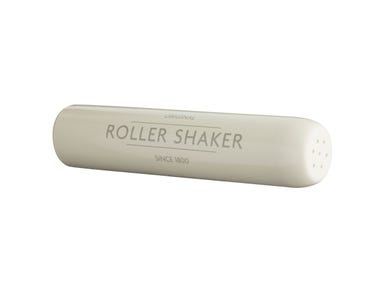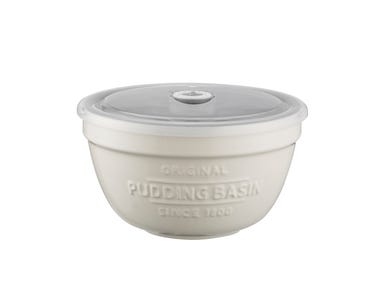
Elaine Boddy's Master Sourdough
Welcome to my master recipe. This is the standard recipe that I use every week to make sourdough loaves for my household.
The key to my process is simplicity, and not having to plan your life around the dough, but being able to fit making sourdough into your home and family life. Making it in a beautiful bowl, with beautiful Mason Cash crockery makes it even better!
The process for making a single loaf can encompass up to 24 hours, but the actual hands on input required is very little, 30 minutes at most.
Top Tip: flours are not all equal and the flour that you use to make sourdough can make a huge difference to the outcome. Using a good quality, dependable, strong white flour is a perfect partner for making sourdough, especially if you are new to this type of bread making. I regularly use and recommend Cotswold Flour strong white flour as it works perfectly with my recipe and process and is a joy to use.
Ingredients and Method
Ingredients
- 50g active starter
- 350ml water
- 500g strong white bread flour
- 7g salt, to taste
- Rice flour, for dusting
Method
- When you want to bake a loaf, you'll first need to make a 'starter'. Take your 'starter' from the fridge and let it come up to room temperature. Feed your starter with 30 grams of strong white bread flour and 30 grams of filtered, or boiled and cooled, water, and stir it all together well. It does not need to be smooth, you do not need to stir it excessively, a few lumpy bits are fine.
- After 50 to 55 minutes, remove the covered pan from the oven. Open the lid to check the loaf, if you feel that your loaf is looking pale, place it back in the hot oven, in its pan, minus the lid, for 5 to 10 minutes to brown the loaf to the colour of your choice.
- Cover the bowl again firmly and allow it to become fully active and ready to use. This can take two to three hours in temperatures well over 20°C, it may take four hours or more in temperatures lower than 20°C, it all depends on the activity of your starter; if yours needs longer to be fully active, build that into your time planning. Top tip: the Mason Cash Pudding Basin with Lid is a perfect size for keeping your starter in, and will prevent you from keeping too much. The air hole in the top also allows your to ‘burp’ your starter if necessary.
- Once the loaf is golden brown, carefully remove it from the pan, remove the parchment paper from the bottom, place the loaf onto a wire rack.
- In your large mixing bowl, combine the bubbly starter with the water and loosely stir them together. They do not need to be perfectly mixed, just swished around to stop the starter from sitting on the bottom of the bowl.
- Leave the loaf on its rack to cool completely. Whichever route you took to bake your loaf, once it is cooling, wait at least 1 hour before you slice into it. If you cut into the loaf too soon, it will still be cooking, plus steam will fill all those carefully crafted holes and make the bread gummy.
- Next, add the strong white bread flour and salt. Mix it all together roughly. Top Tip: The dough does not need to be handled very much at this point, it does not need to be kneaded, and it does not need to be smooth. The only aim here is to loosely mix the starter and water through the flour whether you use your hands, a spoon or a bowl scraper.
- Next, add the strong white bread flour and salt. Mix it all together roughly. Top Tip: The dough does not need to be handled very much at this point, it does not need to be kneaded, and it does not need to be smooth. The only aim here is to loosely mix the starter and water through the flour whether you use your hands, a spoon or a bowl scraper.
- After an hour or so, perform the first set of pulls and folds. This process gives the gluten a workout, stimulates the wild yeast, and builds up the structure in the dough. Pick up a handful of dough from one side of the bowl, using your thumb and two forefingers to grab a portion, lift it, stretch it, and fold it over the rest of the dough to the other side of the bowl; you do not need to pull it too tight. Then, turn the bowl a few degrees and repeat the process—lift and fold, turn the bowl, lift and fold, turn the bowl— and continue until the dough comes together into a smooth-ish ball. Then stop.
- At this point, the dough will be at its stickiest. As you work with it, the stickiness will typically start to reduce. Cover the bowl again with the shower cap and leave it out on the kitchen counter. You can now leave the bowl again for an hour.
- Over the next few hours, perform 3 more sets of the lifting and folding action, exactly the same as before, just enough to bring the dough into a ball; this is the dough telling you when it is time to stop. It will probably take only a few pulls and folds to form it into a ball. Again, these do not need to be done at fixed time periods, as long as you fit in sufficient sets during that time to build up the structure of the dough, which is the key. After each set, cover the bowl and leave it on the counter.
- Replace the shower cap and leave it on the counter overnight to prove. I typically let my dough prove, untouched, for 8 to 10 hours at temperatures of 18-20C. If it is colder where you are it may need longer; if it’s warmer, you will need to make amendments to the dough at the start of the process.
- Next morning you should have a bowl full of grown dough, look for it to double in size. There may or may not be bubbles across the top of your dough; it all depends on what flour you have used, but it is not a requirement.
- Line a 22cm diameter and 8.5cm deep bowl with a clean, dry tea towel dusted with rice flour.
- To place the dough into the bowl, do a series of lifts and folds on the dough, just once around the bowl, a maximum of about 10 actions, to bring it into a ball again. The dough should be bouncy and happy, and you will feel a resistance in the dough. You literally could not squash it flat if you tried, but do not try! Do not be heavy-handed and do not handle the dough too much. The aim at this point is to create a slight tension in the dough to create a ball, without crushing the dough.
- Have your bowl ready and close by. Wet your hand, and place your whole hand over the top of the dough, turn the bowl and everything in it gently upside down with your hand still over the dough, and let the dough come into the palm of your hand, so that it sits in your hand. If the dough sticks to the base of the bowl, gently pull the bowl away to free it.
- Transfer it to the bowl smooth side down. Sprinkle extra rice flour down the sides of the dough, between the dough and the bowl and sprinkle some rice flour all over the top of the dough, too, to prevent it from sticking to the parchment paper later.
- Cover the bowl with the same shower cap that you previously used for the dough, and place in the fridge for a minimum of 3 hours, and up to a maximum of 10. The longer you leave it, the more the flavour will develop, and the dough will firm up. This time in the fridge is often called the final proving and helps the dough to firm up so that when you turn it out from the bowl into the pan to bake, it does not spread and lose its shape.
- When you are ready to bake, you have two choices: to preheat the oven or bake from a cold start. If you choose to preheat the oven, preheat it to 220°C fan assisted or 240C non- fan.
- For either method, have an enamel roaster pan, ideally a 26cm diameter with a lid, as well as good-quality parchment paper.
- To bake, remove the cover from the bowl, place your parchment paper over the top and place the pan upside down over the top of them both. With one hand under the bowl and one hand on top of the pan, turn it all over together to turn the dough out of the banneton and into the pan. You should now have a lovely dome of dough, which holds its shape.
- With a lame or a clean razor blade, score the top of the dough cleanly and firmly, at a depth of 0.5 to 1.0 cm. Always score from the outside toward the middle of the dome, to encourage growth.
- Bake! If you preheated the oven, bake for 50 minutes, keeping the lid on for the entire time. If you are baking from a cold start, place the pan in the cold oven, turn the temperature to 220°C fan or 240°C non-fan and bake for a total of 55 minutes from the time that you placed the pan in the cold oven, with the lid on the entire time.



